Spiral gardens represent a revolutionary approach to maximizing growing space while creating stunning visual focal points in any landscape. These innovative three-dimensional designs transform traditional linear gardening into dynamic, curved formations that enhance both functionality and aesthetic appeal. By coiling garden beds upward in spiral patterns, you can grow significantly more plants in less ground space while creating diverse microclimates for different plant needs. Whether you prefer traditional herb spirals, modern minimalist designs, or creative contemporary variations, these garden concepts offer practical solutions for every gardener. Each design provides unique opportunities to blend permaculture principles with artistic expression, making your outdoor space both productive and beautiful.
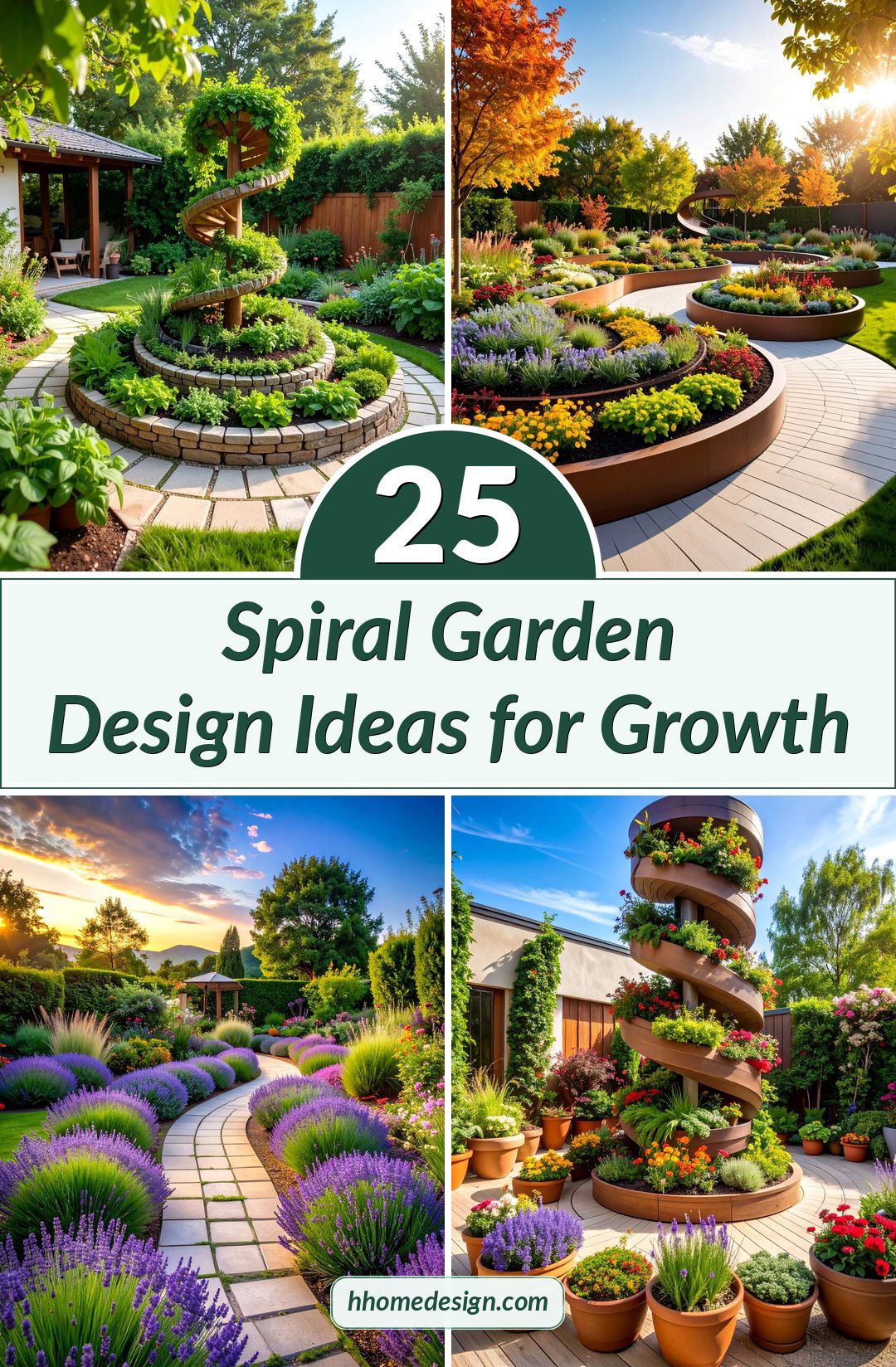
1. Classic Stone Herb Spiral with Mediterranean Plants
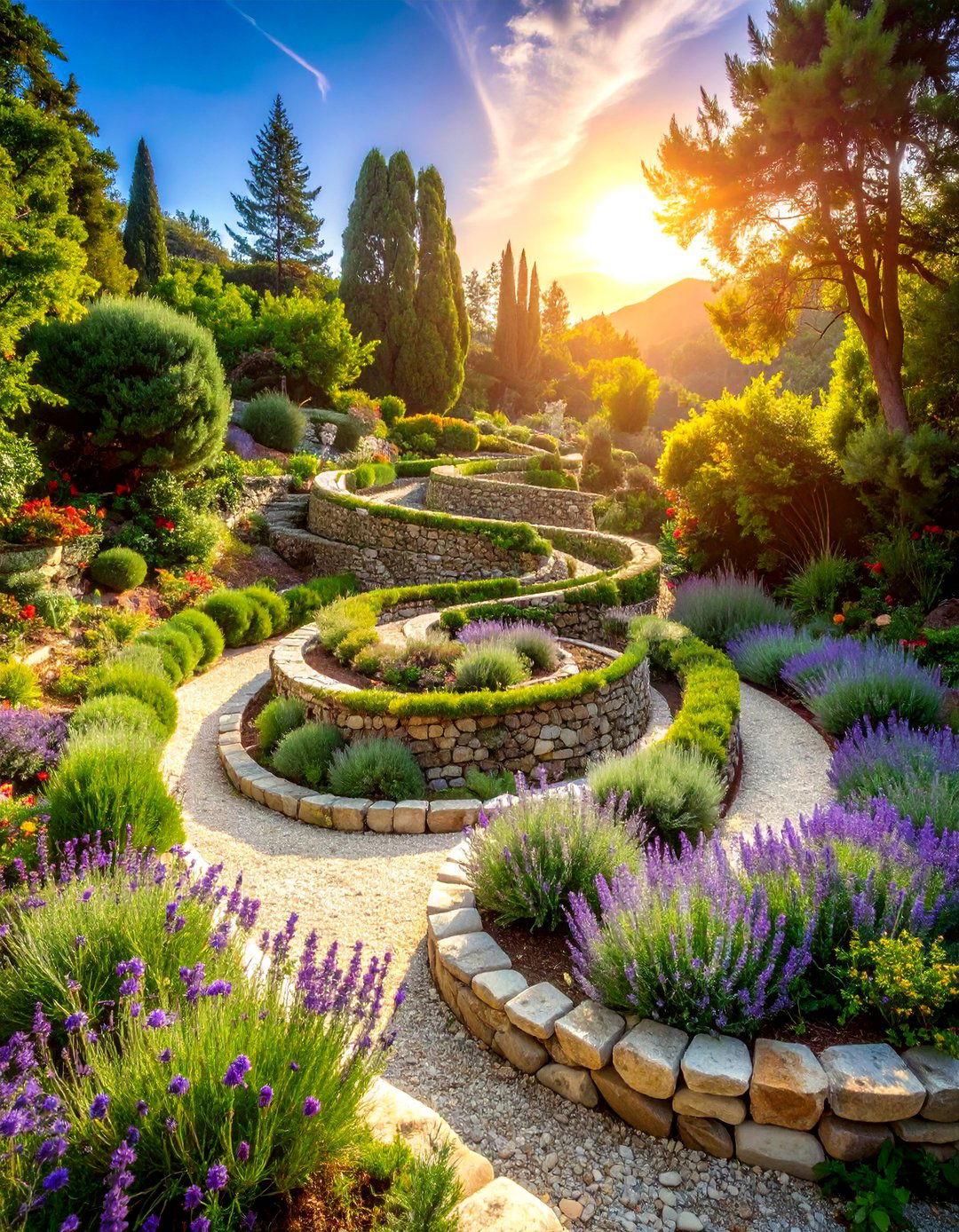
A traditional stone herb spiral creates the perfect environment for Mediterranean herbs like rosemary, thyme, oregano, and sage. The spiral design naturally provides varying levels of sunlight exposure and drainage, with sun-loving plants positioned at the top where conditions are driest and warmest. Build the structure using flat stones stacked in ascending circles, creating a snail-shell pattern that reaches 2-3 feet high at the center. The stones absorb heat during the day and release it at night, extending the growing season for warm-weather herbs. Plant drought-tolerant varieties at the peak and moisture-loving herbs like parsley and chives at the base. This design combines functionality with natural beauty, creating an eye-catching focal point that provides fresh herbs year-round while requiring minimal maintenance once established.
2. Modern Brick Spiral Garden with Geometric Lines

Contemporary brick spiral gardens offer clean, architectural lines that complement modern landscape designs. Using uniform bricks creates precise, geometric patterns while maintaining the functional benefits of spiral gardening. The structured appearance works perfectly in urban settings or formal garden spaces. Build the spiral with standard landscaping bricks, creating straight edges and sharp angles rather than flowing curves. This design accommodates both herbs and compact vegetables, with taller plants positioned strategically to avoid shading shorter ones. The brick construction provides excellent heat retention and creates defined planting zones. Add lighting between brick layers to create stunning evening displays. The geometric approach appeals to gardeners who prefer structured, organized spaces while still maximizing growing potential. This design proves that spiral gardens can be both practical and architecturally striking.
3. Rustic Wooden Spiral Garden with Natural Cedar
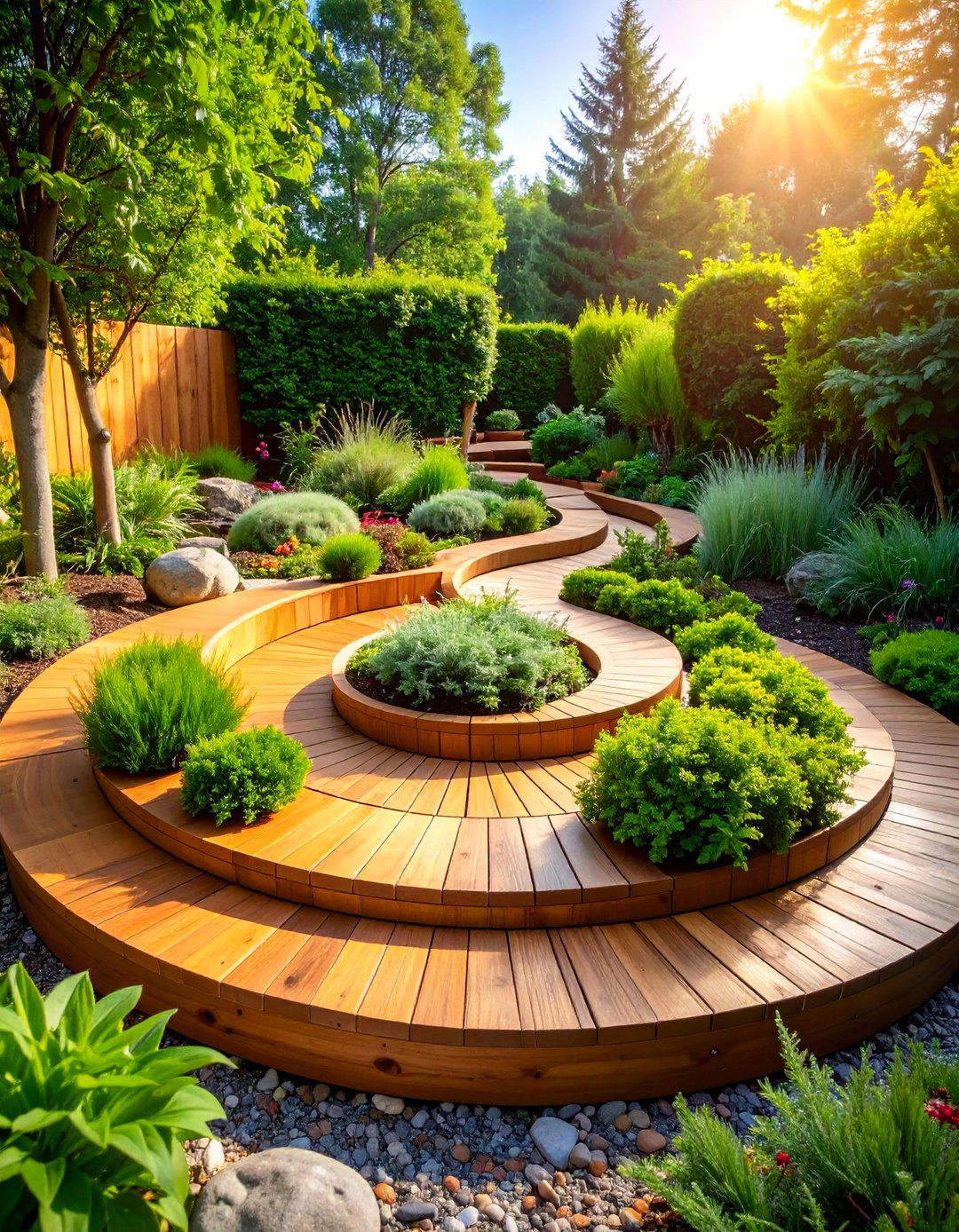
Natural cedar wood creates warm, organic spiral gardens that blend seamlessly with naturalistic landscapes. Cedar's natural rot resistance makes it ideal for outdoor garden construction, while its aromatic properties help deter insects. Build the spiral using cedar logs, planks, or reclaimed lumber arranged in gentle curves that follow natural wood grain patterns. The wood's honey-colored tones complement green foliage beautifully and weather to an attractive silver-gray over time. This design works exceptionally well for cottage gardens or rustic outdoor spaces. Plant a combination of culinary herbs, edible flowers, and small vegetables throughout the spiral. The wood retains moisture better than stone, creating slightly different growing conditions that benefit plants requiring consistent soil moisture. Regular applications of natural wood preservative extend the structure's lifespan while maintaining its organic appeal.
4. Vertical Tower Spiral Garden for Small Spaces

Maximize growing space in tiny yards or patios with vertical tower spiral gardens that grow upward rather than outward. These compact designs use tiered planters arranged in spiraling formations, creating impressive growing capacity within a minimal footprint. Build using stackable containers, wooden boxes, or custom-designed vertical structures with spiral planting pockets. Each level receives different amounts of sunlight and water drainage, creating natural microclimates. Position trailing plants like strawberries or herbs at various levels to create cascading effects. The vertical design makes harvesting easy and provides excellent air circulation around plants. Perfect for urban balconies, small patios, or anywhere space is limited. Consider adding drip irrigation systems to ensure even water distribution throughout all levels. This innovative approach proves that even the smallest spaces can accommodate productive, beautiful spiral gardens.
5. Keyhole Spiral Garden with Central Compost Access
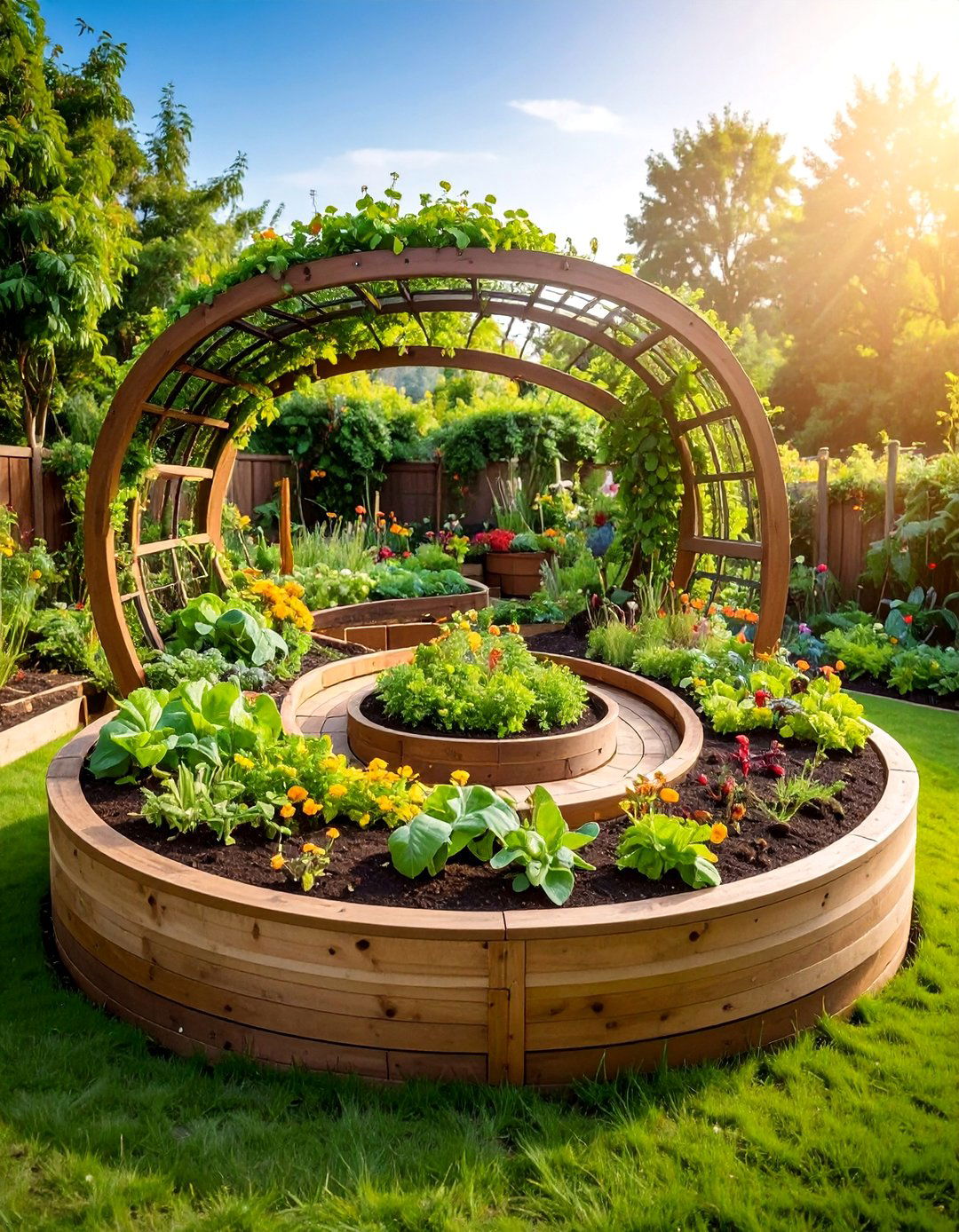
Combine spiral design with keyhole gardening principles by creating a horseshoe-shaped spiral with a composting center. This permaculture-inspired design features a central composting basket that feeds nutrients directly to surrounding plants through natural drainage. Build the spiral wall around a wire or stone composting cylinder, leaving a narrow entrance for easy access. As kitchen scraps and organic matter decompose in the center, nutrients seep into the surrounding soil, creating incredibly fertile growing conditions. The keyhole design allows you to reach all planting areas from the central path, reducing soil compaction. Plant heavy feeders like tomatoes and peppers near the composting center, with lighter feeders positioned further away. This self-sustaining system reduces waste while providing excellent growing conditions. The design works particularly well in permaculture gardens focused on sustainability and resource cycling.
6. Zen Minimalist Spiral Garden with Gravel Paths
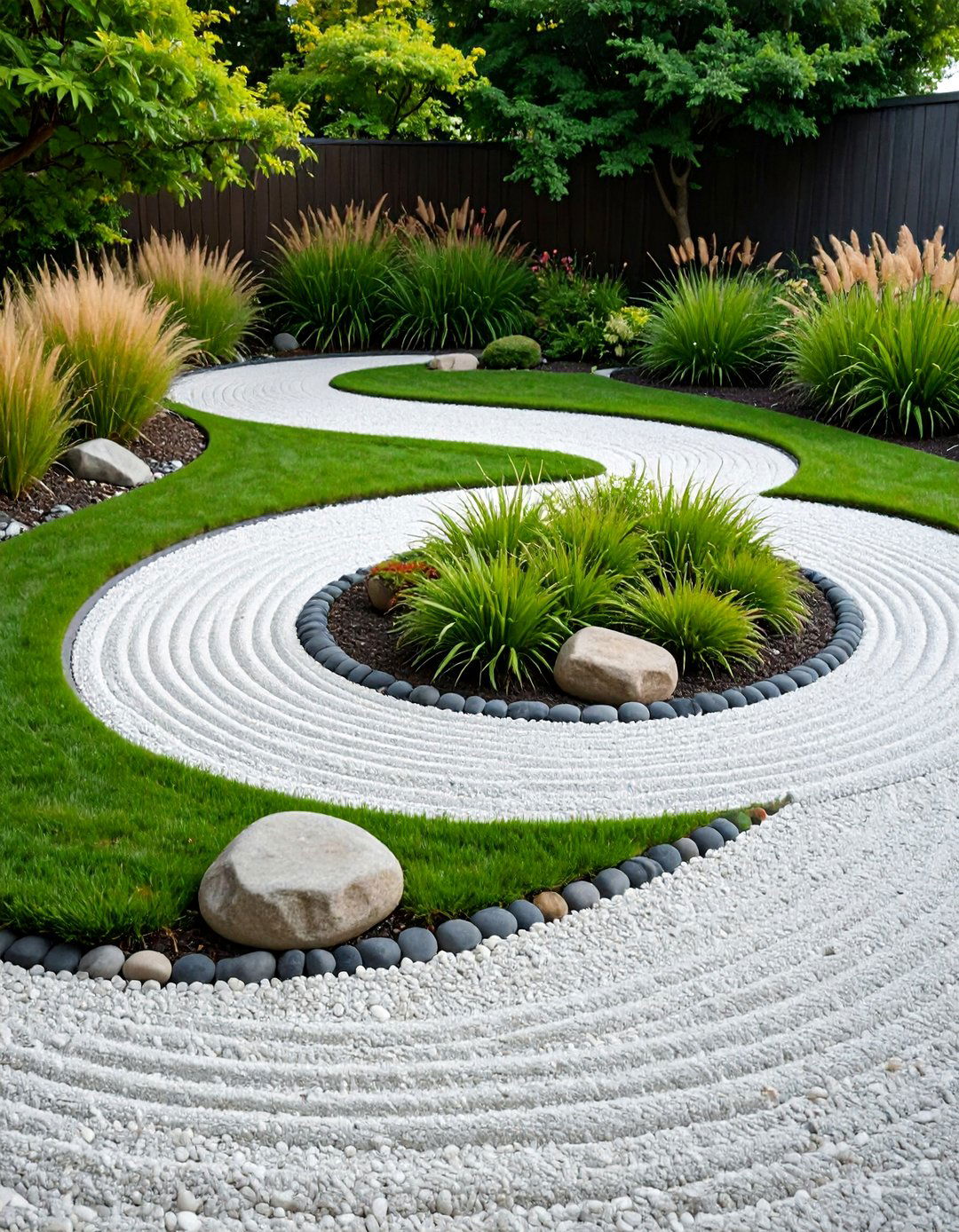
Create a peaceful, contemplative space with minimalist spiral gardens featuring clean lines and carefully selected plants. This design emphasizes simplicity and balance, using neutral-colored stones or concrete blocks arranged in gentle spirals. Incorporate gravel pathways and strategically placed boulders to enhance the meditative quality. Plant selection focuses on texture and form rather than bright colors, featuring ornamental grasses, sedums, and architectural plants like hostas or ferns. The spiral design naturally guides movement and creates a sense of journey through the space. Add subtle lighting for evening meditation or contemplation. Water features like small fountains or reflecting pools complement the zen aesthetic. This design appeals to gardeners seeking tranquil outdoor spaces that provide stress relief and mental restoration. The minimalist approach requires less maintenance while creating maximum visual impact through thoughtful plant and material selection.
7. Raised Bed Spiral Garden with Timber Frames

Elevated spiral gardens using timber-framed raised beds provide excellent drainage and easier access for gardeners of all abilities. Build the spiral using treated lumber or naturally rot-resistant wood like cedar, creating boxes of varying heights that spiral upward. The raised design improves soil warming in spring and provides better growing conditions for root vegetables and herbs. Fill with high-quality potting soil and compost for optimal plant nutrition. The timber frames allow precise control over soil composition and drainage. This design works well for gardeners with mobility issues or those wanting to avoid bending and kneeling. Install drip irrigation systems easily within the structured framework. The clean, organized appearance suits formal garden settings while providing practical growing space. Regular wood treatment maintains appearance and extends the lifespan of the construction. This approach combines the benefits of raised bed gardening with spiral design efficiency.
8. Contemporary Steel and Concrete Spiral Garden
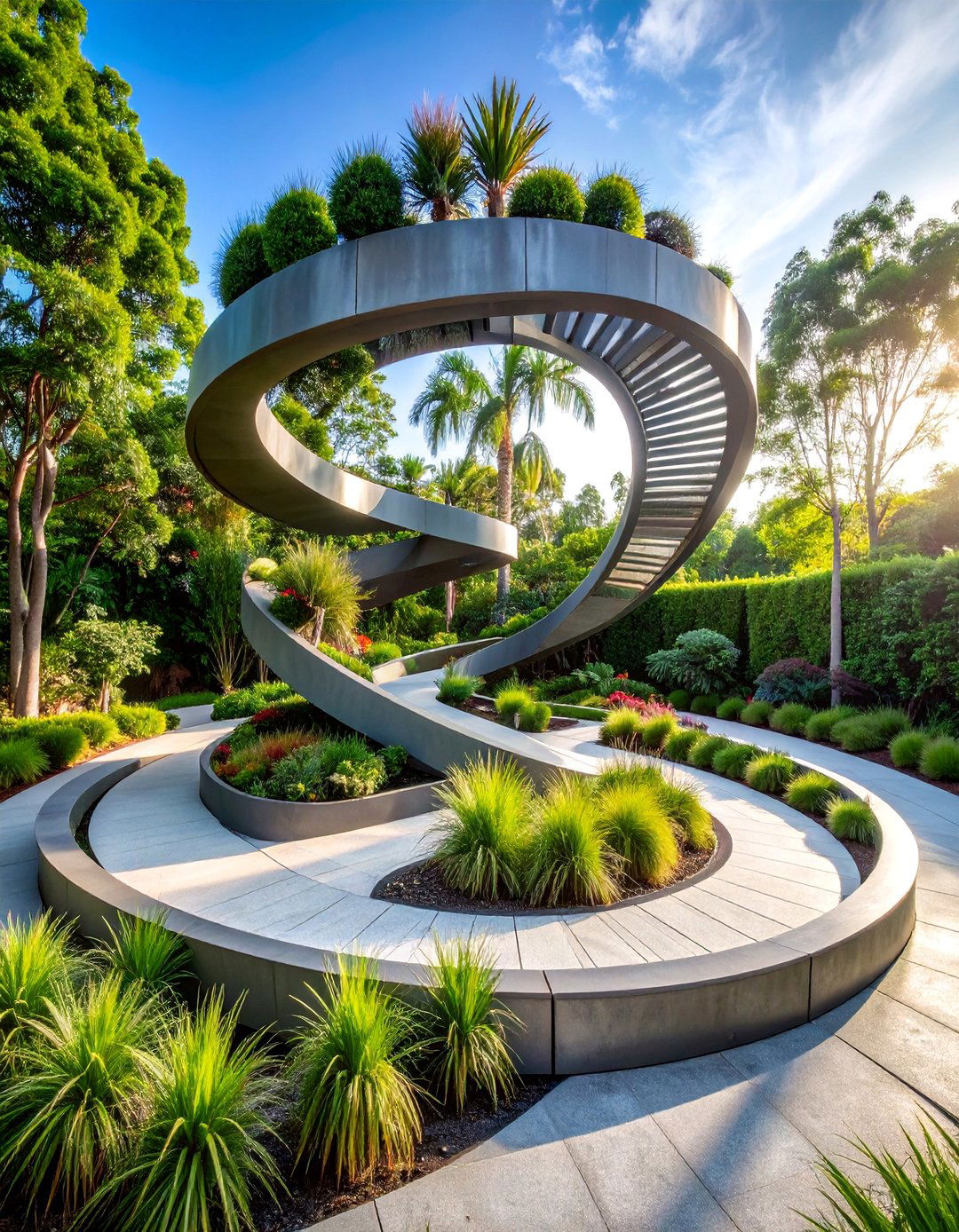
Modern materials like weathering steel and concrete create striking contemporary spiral gardens that serve as landscape art pieces. These durable materials withstand harsh weather conditions while developing attractive patina over time. Design the spiral using curved steel planters or poured concrete forms that create flowing, sculptural shapes. The industrial aesthetic complements modern architecture and urban landscapes. Plant with architectural specimens like ornamental grasses, succulents, and structural perennials that echo the clean lines of the construction. The thermal mass of concrete and steel helps moderate soil temperatures. These materials require minimal maintenance while providing decades of service. Incorporate LED strip lighting within the structure for dramatic nighttime effects. This design appeals to gardeners who appreciate contemporary art and want their gardens to make bold architectural statements. The investment in quality materials pays dividends in longevity and visual impact.
9. Spiral Rock Garden with Alpine Plants

Create stunning spiral rock gardens featuring alpine and succulent plants that thrive in well-drained, rocky conditions. Use a mixture of stone sizes to create natural-looking formations that spiral upward, mimicking mountain landscapes. The excellent drainage provided by rocks suits plants like sedums, sempervivums, alpine phlox, and creeping thyme. Position larger accent stones strategically throughout the spiral to create focal points and planting pockets. The thermal mass of rocks moderates temperature fluctuations and provides stability for root systems. This design requires minimal watering once established, making it perfect for drought-prone areas or water-wise gardening. Add small bulbs like crocuses and dwarf iris for spring color. The natural appearance blends seamlessly with existing landscape features. Regular weeding keeps the design clean and allows featured plants to shine. This low-maintenance approach provides year-round interest through varied textures and forms.
10. Culinary Herb Spiral Garden with Kitchen Access

Position culinary herb spirals near kitchen entrances for convenient harvesting during meal preparation. Design the spiral to include all essential cooking herbs: basil, oregano, thyme, rosemary, sage, parsley, chives, and cilantro. Arrange plants according to their sun and water requirements, with Mediterranean herbs at the top and moisture-loving varieties at the base. The spiral design extends the growing season by creating multiple microclimates within a small space. Include stepping stones or narrow paths for easy access during harvesting. Plant succession crops of quick-growing herbs like cilantro and basil every few weeks for continuous harvests. Add edible flowers like nasturtiums and calendula for colorful garnishes. Consider the mature size of each plant when positioning to prevent overcrowding. Install subtle lighting for evening harvesting. This practical design transforms cooking by providing fresh, flavorful herbs just steps from the kitchen, encouraging creative culinary exploration.
11. Drought-Tolerant Spiral Garden with Native Plants

Design water-wise spiral gardens using drought-tolerant native plants that thrive with minimal irrigation once established. Research plants native to your region and arrange them according to their specific water and sun requirements throughout the spiral. Native plants provide food and habitat for local wildlife while requiring less maintenance than exotic species. The spiral design creates natural water catchment areas that maximize rainfall efficiency. Use mulch heavily to retain soil moisture and suppress weeds. Include native grasses, wildflowers, and shrubs that provide year-round interest through varied blooming periods and seasonal changes. This approach supports local ecosystems while creating beautiful, sustainable gardens. Add bird baths or small water features to attract beneficial wildlife. The design works particularly well in areas with water restrictions or challenging growing conditions. Regular monitoring helps establish optimal watering schedules that support plant health while conserving water resources.
12. Container Spiral Garden for Patio Spaces

Create mobile spiral gardens using containers of varying sizes arranged in spiraling patterns on patios, decks, or balconies. This flexible approach allows gardeners to rearrange designs seasonally or move plants to optimal growing conditions. Use lightweight containers made from fiberglass, plastic, or fabric for easy handling. Arrange pots in ascending heights to create the spiral effect, with largest containers at the base graduating to smaller ones at the top. This design provides excellent drainage control and allows customized soil mixes for different plant types. Include trailing plants that spill over container edges to soften the appearance. Install drip irrigation systems or self-watering containers to maintain consistent moisture. The portability enables year-round gardening by moving tender plants indoors during winter. This approach suits renters or gardeners who prefer flexible, non-permanent installations. Regular container rotation ensures even plant growth and prevents root binding.
13. Therapeutic Spiral Garden with Sensory Plants
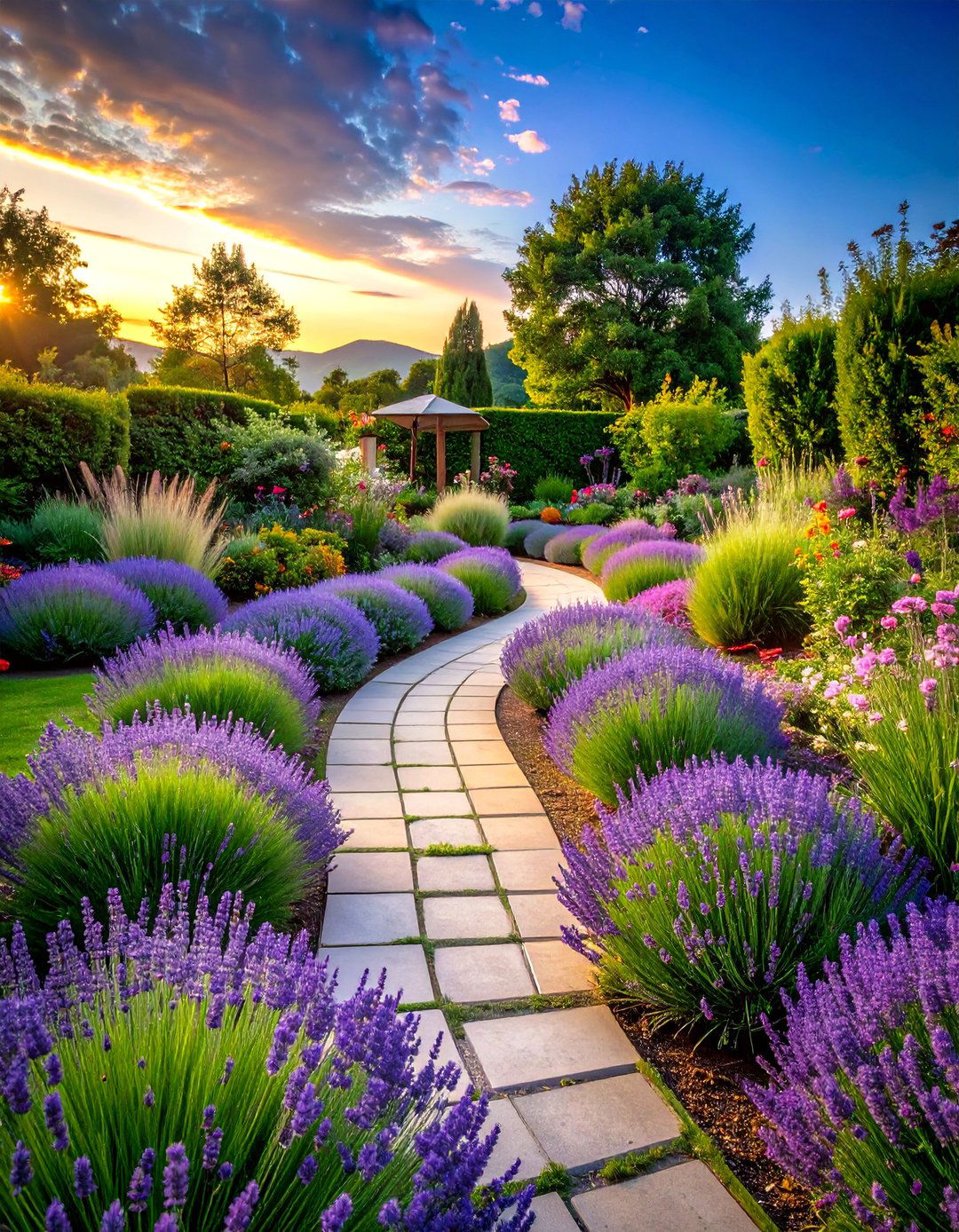
Design healing spiral gardens that engage all five senses through carefully selected plants and materials. Include fragrant herbs like lavender, mint, and lemon balm that provide aromatherapy benefits. Add textural plants like lamb's ear and ornamental grasses that invite touching. Include edible flowers and herbs for taste experiences, and plants with interesting sounds like rustling grasses or seed pods. Choose colorful plants that provide visual stimulation and change throughout seasons. The spiral design naturally creates a meditative walking path that encourages slow, mindful movement. Include comfortable seating areas for rest and contemplation. This design particularly benefits individuals with dementia, depression, or anxiety by providing therapeutic engagement with nature. Use smooth, rounded stones and avoid sharp edges for safety. Regular maintenance keeps the space inviting and accessible. The therapeutic benefits extend to caregivers and family members who enjoy working in these peaceful environments.
14. Multi-Season Spiral Garden with Year-Round Interest
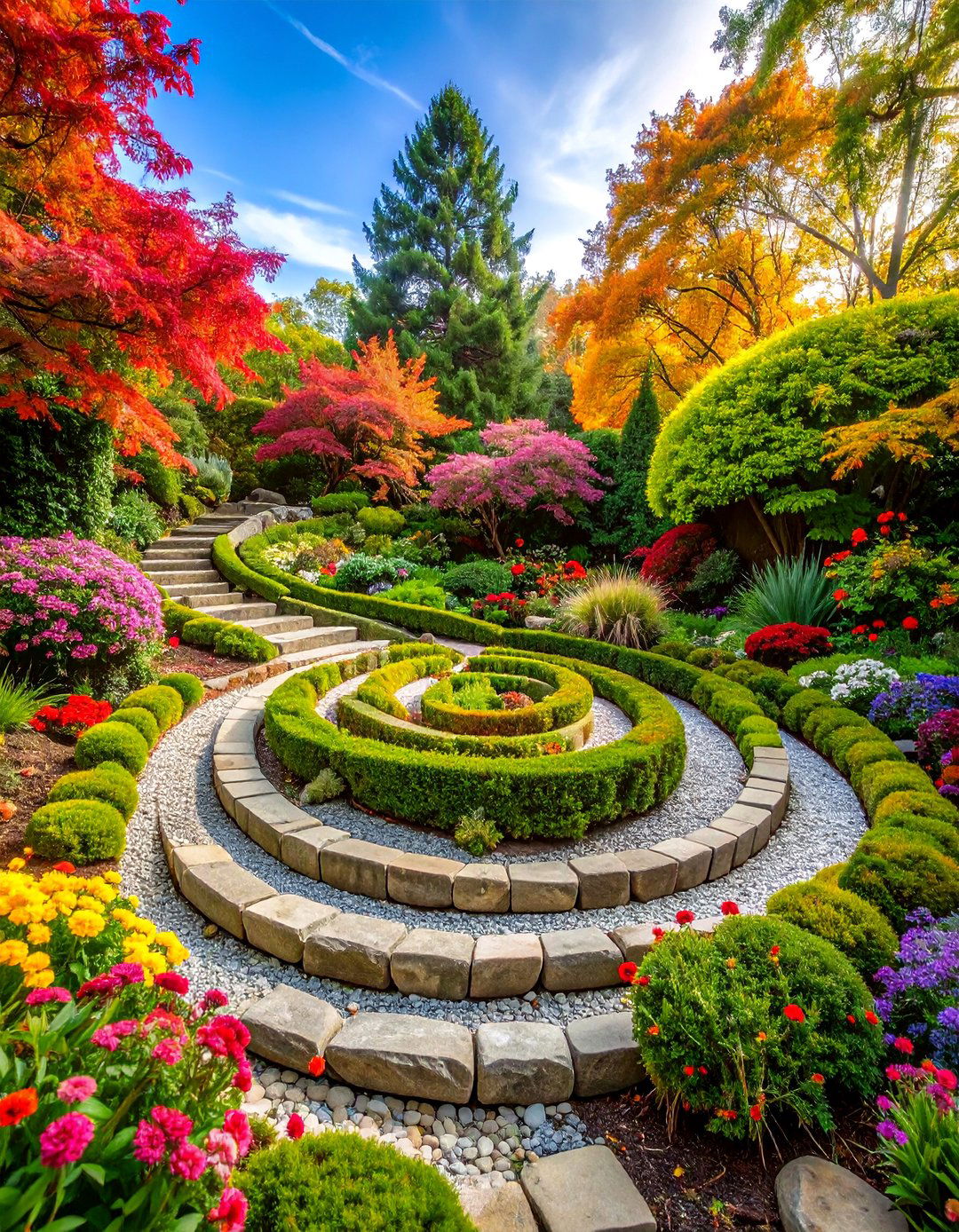
Plan spiral gardens that provide visual interest throughout all four seasons by selecting plants with varied blooming periods, foliage colors, and structural forms. Include spring bulbs at the base, summer-flowering perennials at mid-levels, and fall-blooming asters or mums at the top. Add evergreen herbs and ornamental grasses for winter structure. The spiral design showcases seasonal transitions as different areas peak at various times. Include plants with colorful fall foliage, interesting bark, or seed heads that persist into winter. Add seasonal decorations or lighting to enhance winter appeal. This approach ensures the garden remains attractive year-round rather than looking dormant during off-seasons. Regular planning and plant replacement maintain continuous interest. Include early spring flowers that provide hope after long winters. The design rewards gardeners who appreciate subtle seasonal changes and want maximum value from their garden investments.
15. Wildlife Habitat Spiral Garden with Native Ecosystem
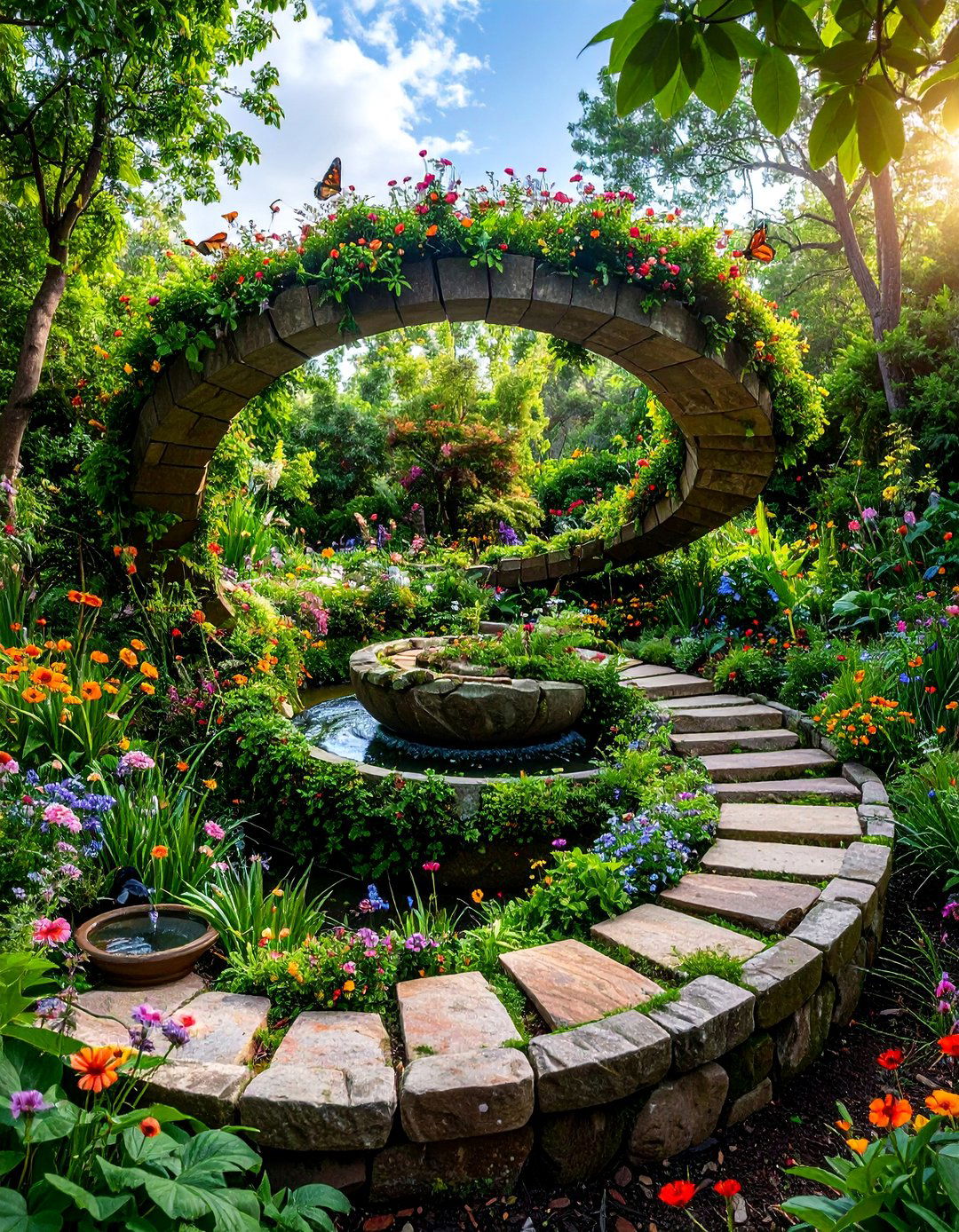
Create spiral gardens specifically designed to support local wildlife by including native plants that provide food, shelter, and nesting sites for birds, butterflies, and beneficial insects. Research plants that support specific wildlife species in your region and arrange them throughout the spiral according to their growing requirements. Include host plants for butterfly larvae and nectar sources for adult butterflies. Add berry-producing shrubs and seed-producing flowers for bird food. The spiral design creates diverse microclimates that support various species preferences. Include small water features like shallow dishes or fountains for drinking and bathing. Avoid pesticides and chemicals that harm beneficial insects. Leave some areas undisturbed for overwintering beneficial insects. The design provides educational opportunities for children to observe wildlife behavior. Regular monitoring helps identify successful plant-wildlife relationships. This approach contributes to local ecosystem health while creating beautiful, dynamic gardens that change with wildlife activity.
16. Compact Urban Spiral Garden with Vertical Elements
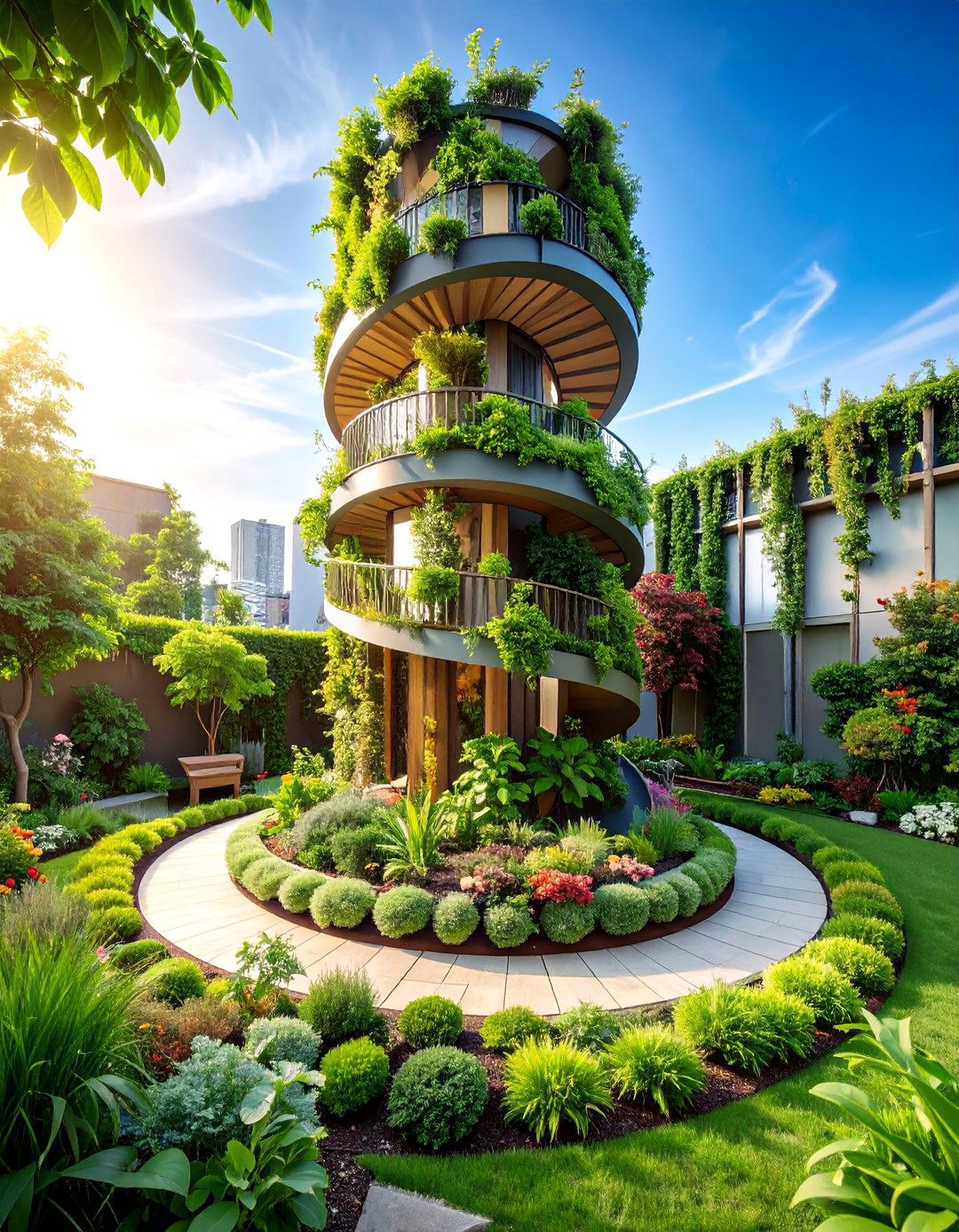
Maximize growing space in small urban yards by designing compact spiral gardens that incorporate vertical growing elements. Use trellises, stakes, or cages to support climbing plants like peas, beans, and cucumbers within the spiral structure. The vertical elements add height and visual interest while increasing productivity. Choose compact plant varieties suited to close spacing and intensive growing methods. Include succession planting schedules to maintain continuous harvests throughout the growing season. The spiral design efficiently organizes different plant types while creating attractive displays. Add lighting for evening visibility in urban settings. Use reflective surfaces or light-colored mulches to maximize available light in shadowed areas. This design proves that productive gardens thrive even in challenging urban environments. Regular harvesting and maintenance keep the space tidy and productive. The compact nature makes this approach ideal for townhouses, condominiums, or small lots where space maximization is essential.
17. Gabion Wire Spiral Garden with Stone Fill

Construct modern spiral gardens using gabion wire baskets filled with stones, creating attractive retaining walls that define planting areas. The wire and stone construction provides excellent drainage while creating unique textural interest. Use uniform stone sizes and colors for contemporary looks, or mix materials for rustic appeal. The gabion construction allows for precise height control and creates strong retaining walls for sloped sites. Fill planting areas with high-quality soil and compost for optimal growing conditions. The stone thermal mass moderates soil temperatures and provides plant roots with stable growing conditions. This construction method works well for gardeners who want permanent, low-maintenance structures. Include lighting within or behind gabion walls for dramatic evening effects. The industrial aesthetic complements modern landscape designs while providing practical growing space. Regular topping off of stone fill maintains appearance and structural integrity. This approach appeals to gardeners interested in contemporary design elements.
18. Spiral Cutting Garden with Flower Production
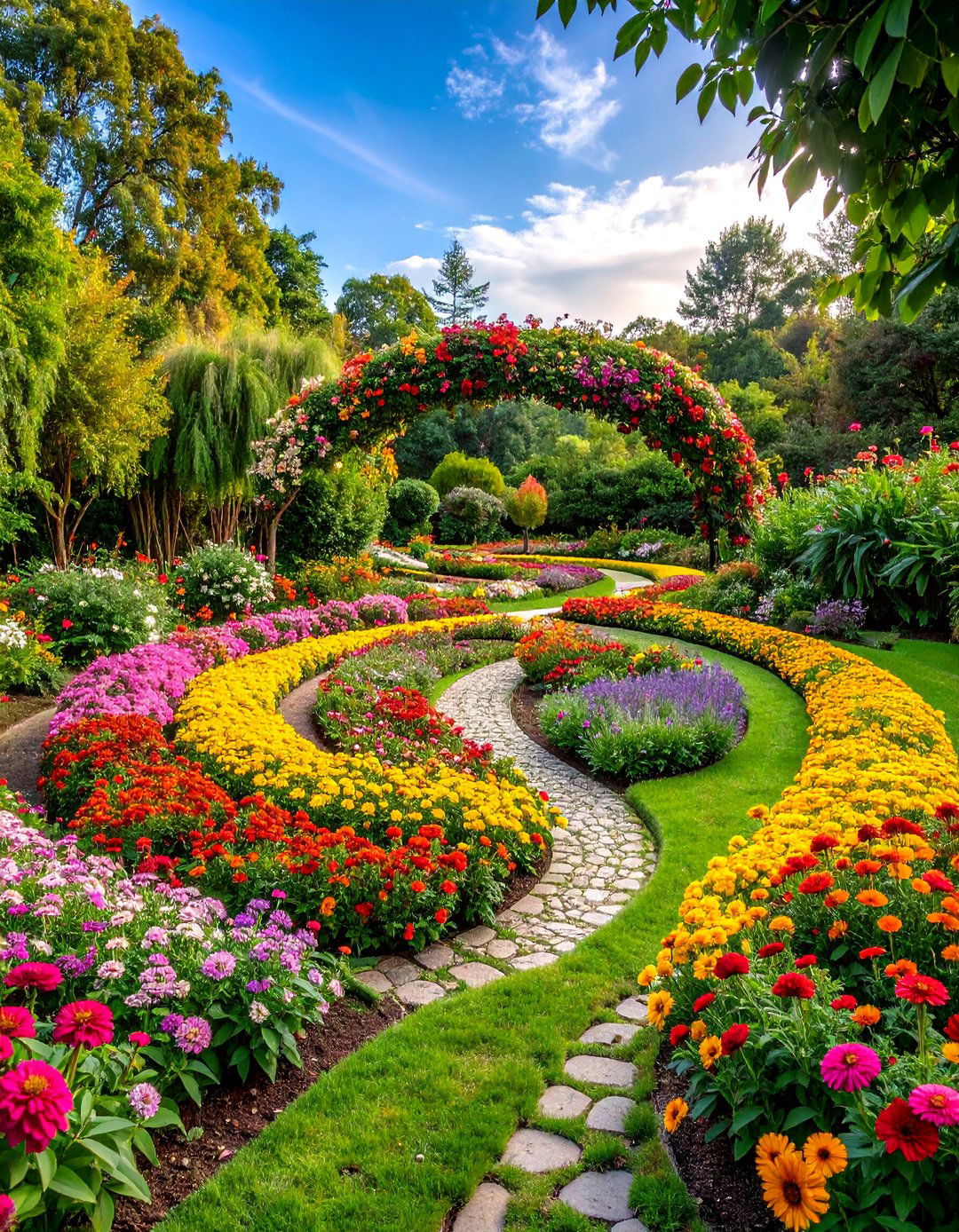
Design spiral gardens specifically for cut flower production by selecting plants that provide abundant blooms for indoor arrangements. Include flowers with various heights, colors, and blooming periods to ensure continuous cutting material. Plant zinnias, cosmos, sunflowers, and marigolds for easy-to-grow options, along with more specialized cut flowers like lisianthus or delphiniums. The spiral design organizes plants by height and blooming time for efficient harvesting. Include foliage plants like hosta or ferns for greenery in arrangements. Plant in succession to maintain flowering throughout the growing season. The design creates attractive garden displays while providing practical cutting material. Add paths for easy harvesting access without damaging surrounding plants. Include a small work area for initial flower processing and conditioning. This approach appeals to gardeners who enjoy flower arranging or want to reduce flower-buying expenses. Regular cutting encourages continued bloom production and maintains plant health.
19. Accessible Spiral Garden with Raised Heights
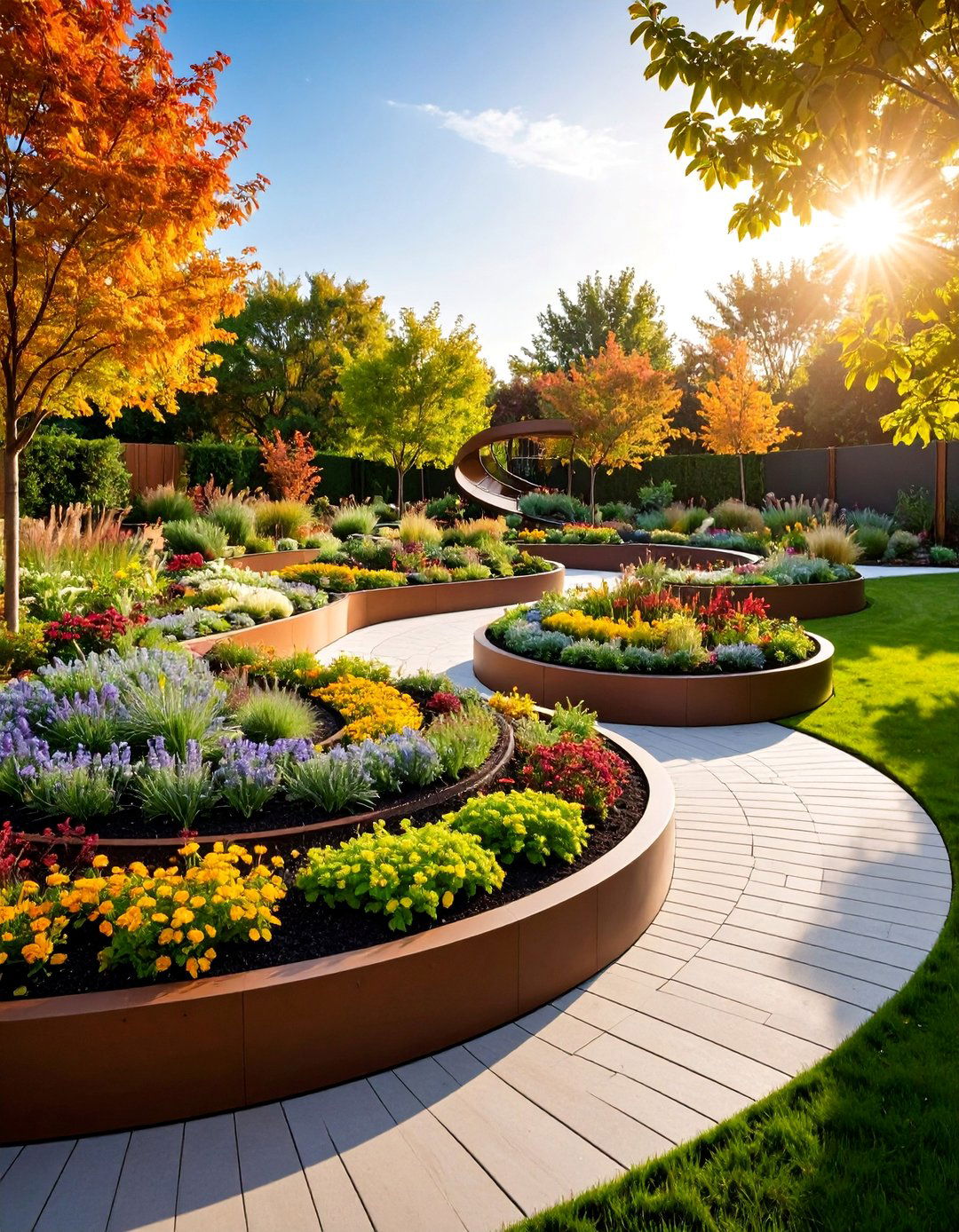
Design spiral gardens specifically for accessibility by creating raised planting areas that accommodate wheelchairs, walkers, or gardeners with mobility limitations. Build the spiral at varying heights from 24-36 inches to allow comfortable reach from seated or standing positions. Use wide, stable pathways with non-slip surfaces for safe navigation. Include knee space under raised sections for wheelchair access. The spiral design provides maximum growing space while maintaining accessibility from multiple angles. Use lightweight tools and easy-care plants that require minimal maintenance. Include comfortable seating areas for rest during gardening activities. Install drip irrigation systems to reduce watering labor. The design creates opportunities for therapeutic gardening that benefit physical and mental health. Regular maintenance keeps pathways clear and safe. This approach ensures that physical limitations don't prevent gardening enjoyment and demonstrates that beautiful, productive gardens can be accessible to all abilities.
20. Edible Landscape Spiral Garden with Food Production

Transform ornamental spirals into productive food gardens by selecting edible plants that provide beauty and nutrition. Include edible flowers like pansies and nasturtiums, colorful vegetables like purple cabbage and rainbow chard, and attractive fruit plants like strawberries and dwarf fruit trees. The spiral design showcases the natural beauty of food plants while maximizing production in small spaces. Arrange plants according to their mature sizes and growing requirements, with tall crops at the back and low-growing plants in front. Include herbs that serve dual purposes as seasoning and pest deterrents. The design proves that food gardens can be as attractive as ornamental landscapes. Add companion plants that improve soil health and natural pest control. Regular harvesting maintains plant productivity and garden appearance. This approach appeals to gardeners interested in sustainable living and reducing grocery expenses while creating beautiful landscape features.
21. Spiral Rain Garden with Water Management

Design spiral gardens that manage stormwater runoff while creating attractive planted areas. Position the spiral in natural low spots or create gentle depressions that capture and filter rainwater. Use plants that tolerate both wet and dry conditions throughout different areas of the spiral. The design slows water flow and allows infiltration rather than rapid runoff. Include native plants that naturally filter pollutants and provide habitat for beneficial insects. The spiral shape creates varying depths and moisture levels that support diverse plant communities. Add decorative stones or gravel to enhance infiltration and create attractive dry creek bed effects during non-rain periods. This approach addresses environmental concerns while creating beautiful garden features. Regular maintenance includes removing sediment buildup and replacing plants as needed. The design demonstrates how gardens can provide ecological services while enhancing property values. Include educational signage explaining the environmental benefits to visitors and neighbors.
22. Spiral Moonlight Garden with Evening Bloomers

Create magical spiral gardens designed for evening enjoyment by selecting plants that bloom at night or provide silvery, reflective foliage. Include evening primrose, four o'clocks, moonflowers, and night-blooming cereus for nocturnal flowers. Add plants with white or silver foliage like dusty miller, lamb's ear, and artemisia that reflect moonlight and artificial lighting. The spiral design creates intimate spaces for evening relaxation and entertainment. Include comfortable seating areas and subtle lighting that doesn't interfere with night-blooming plants or nocturnal wildlife. Add fragrant plants like night-blooming jasmine or tuberose that release intense scents in the evening. This design appeals to gardeners who work during the day and want to enjoy their gardens in the evening. Include plants that attract night-flying pollinators like moths and bats. Regular evening maintenance ensures plants remain healthy and attractive. The design creates romantic, peaceful spaces perfect for stress relief after busy days.
23. Spiral Succulent Garden with Desert Plants

Design striking spiral gardens using drought-tolerant succulents and desert plants that require minimal water and maintenance. Include agaves, aloes, sedums, and echeverias arranged according to their size and growth habits. The spiral design showcases the architectural forms and varied textures of succulent plants while providing excellent drainage. Use gravel or decomposed granite pathways that complement the desert aesthetic. Add accent rocks or boulders to create focal points and provide scale contrast. The design works particularly well in hot, dry climates or for gardeners seeking low-maintenance landscapes. Include seasonal color with flowering cacti and succulents like barrel cactus or prickly pear. The thermal mass of the spiral structure helps moderate temperature extremes. Regular minimal watering during establishment helps plants develop strong root systems. This approach proves that water-wise gardens can be incredibly beautiful and diverse while requiring minimal ongoing care. Include safety considerations for thorny or sharp plants in high-traffic areas.
24. Spiral Medicinal Herb Garden with Healing Plants
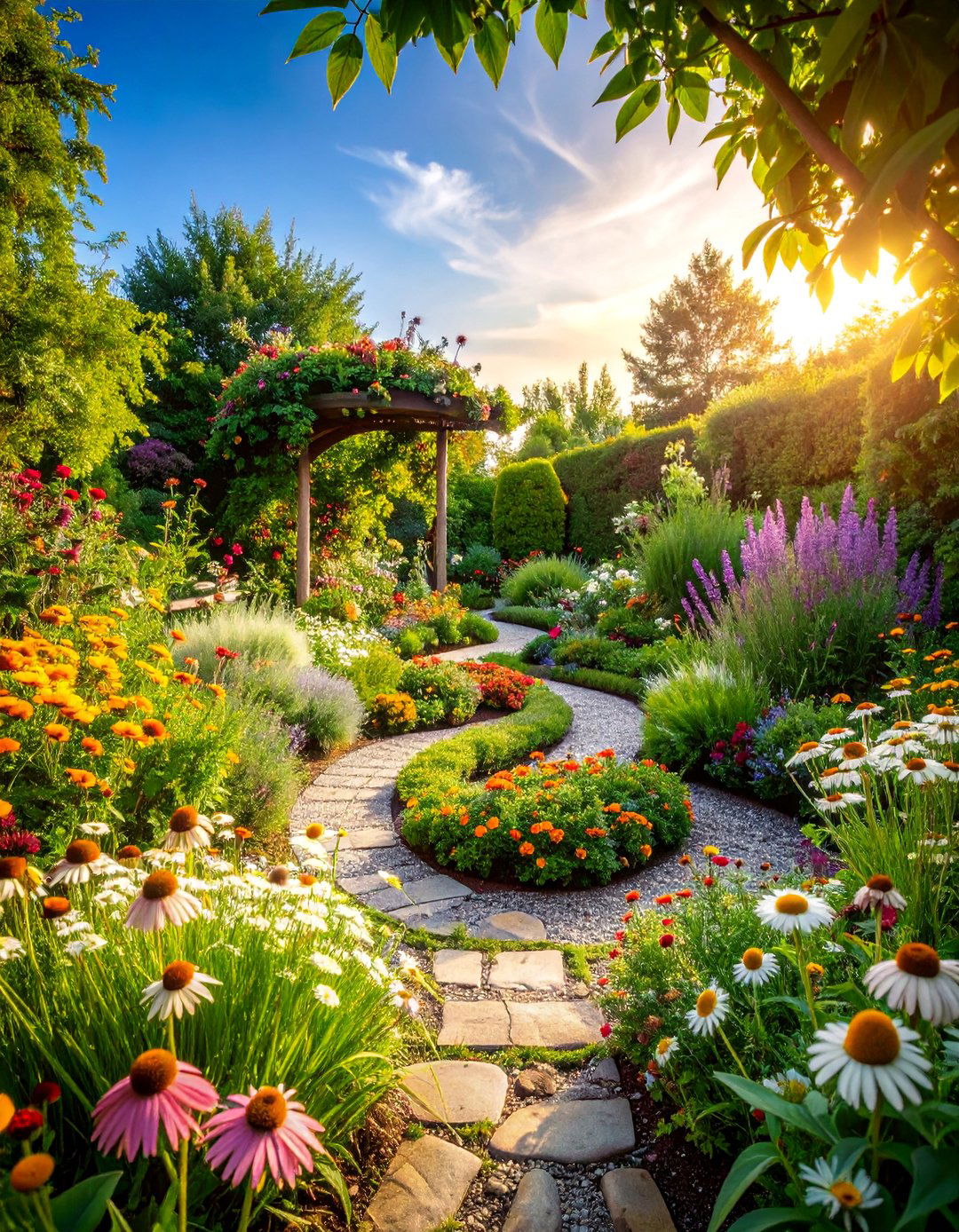
Create spiral gardens focused on medicinal and healing herbs that provide natural remedies and therapeutic benefits. Include traditional healing plants like echinacea, calendula, comfrey, and chamomile arranged according to their growing requirements. The spiral design organizes plants by their medicinal properties and harvesting times. Include informational markers identifying plants and their traditional uses. Plant preparation areas nearby for drying and processing herbs. The design provides educational opportunities about traditional plant medicine and natural healing. Include plants used for teas like peppermint, lemon balm, and chamomile. Add aromatherapy plants like lavender and rosemary that provide stress relief through scent. This approach appeals to gardeners interested in natural health and traditional remedies. Regular research ensures accurate plant identification and safe usage. Include consultation with healthcare providers before using medicinal plants. The design creates peaceful, healing environments that support both physical and mental well-being.
25. Contemporary Spiral Garden with Modern Materials
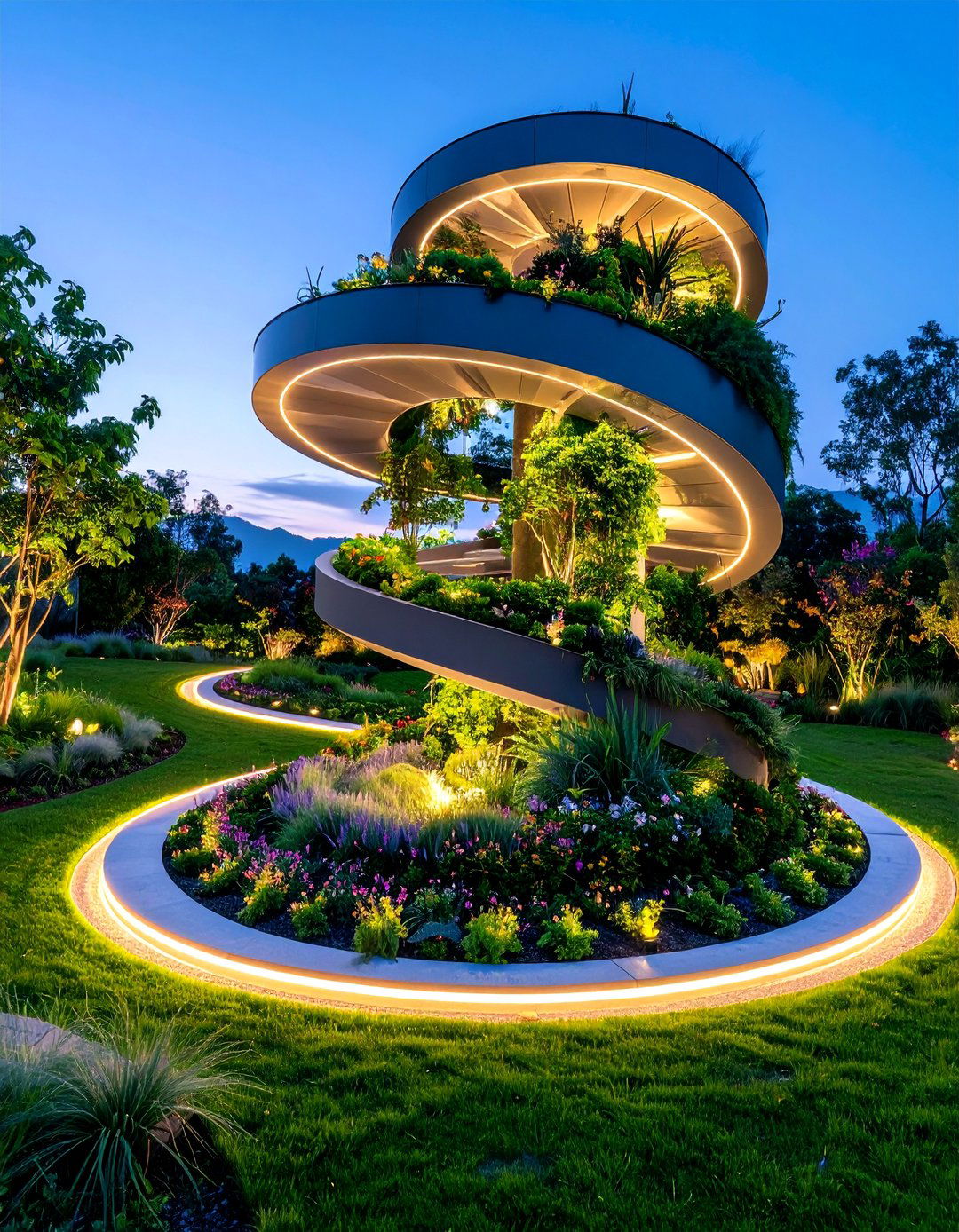
Design cutting-edge spiral gardens using contemporary materials like composite lumber, powder-coated steel, or recycled plastic lumber that provide durability and modern aesthetics. These materials resist weathering and require minimal maintenance while providing clean, architectural lines. The spiral design incorporates geometric patterns and bold color contrasts that complement contemporary architecture. Include modern plant selections like ornamental grasses, architectural perennials, and structural evergreens. Add integrated lighting systems and automated irrigation for high-tech convenience. The design appeals to gardeners who appreciate modern design and want low-maintenance, long-lasting installations. Use modular construction techniques that allow future modifications or expansions. Include sustainable features like rainwater collection or solar-powered lighting. Regular cleaning maintains the contemporary appearance and extends material lifespan. This approach demonstrates how traditional spiral garden concepts can be updated with modern materials and technology while maintaining their essential functionality and beauty.
Conclusion:
Spiral gardens offer endless possibilities for creating beautiful, productive, and innovative outdoor spaces that maximize growing potential while providing stunning visual appeal. These designs prove that gardens can be both functional and artistic, serving multiple purposes from food production to therapeutic relaxation. Whether you choose traditional stone construction, modern materials, or creative contemporary variations, spiral gardens adapt to any style preference or space limitation. The diverse microclimates created by spiral designs support plant diversity while creating dynamic, ever-changing displays throughout the seasons. By incorporating permaculture principles, accessibility features, or specialized themes, these gardens serve individual needs while contributing to environmental sustainability and community well-being.



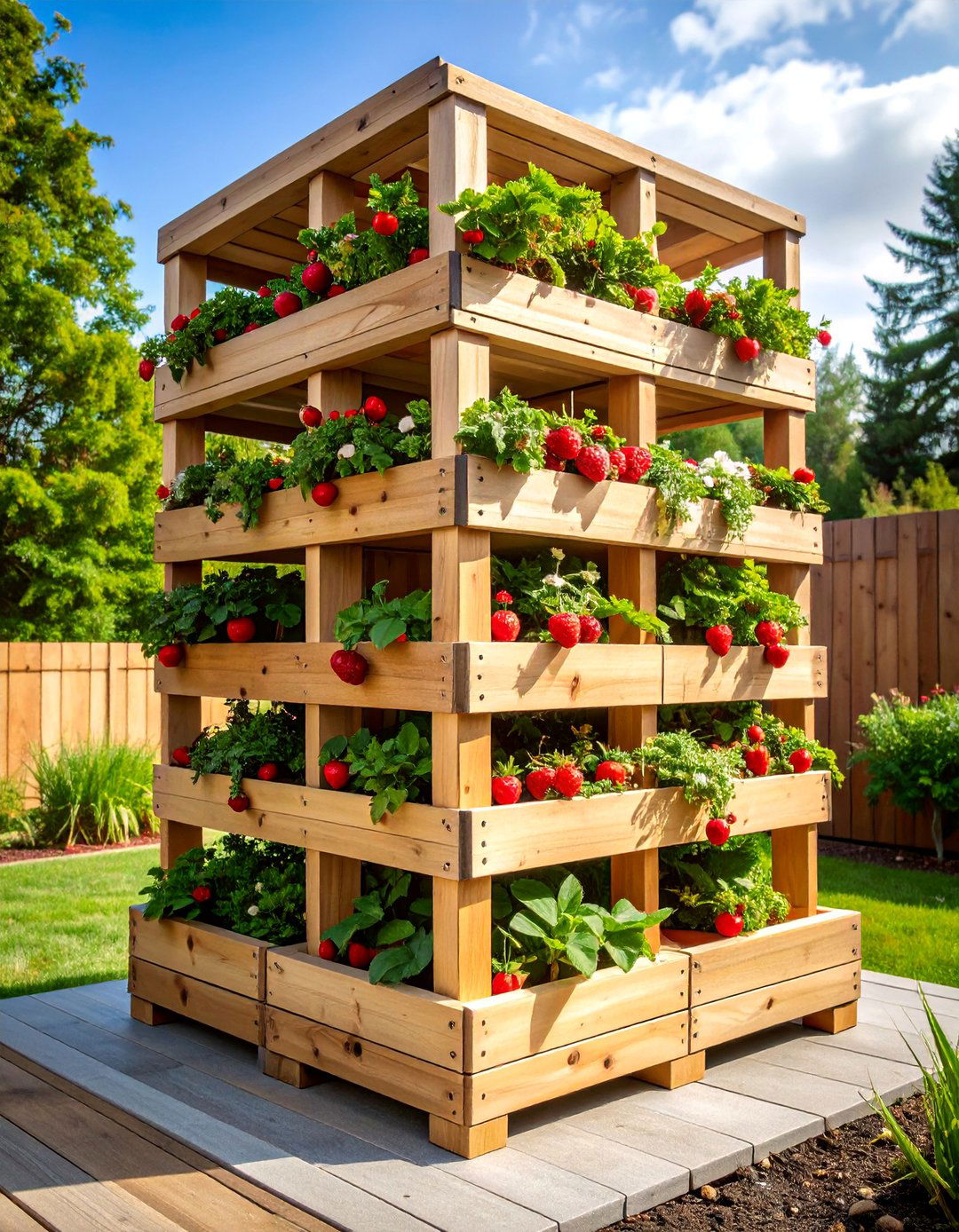


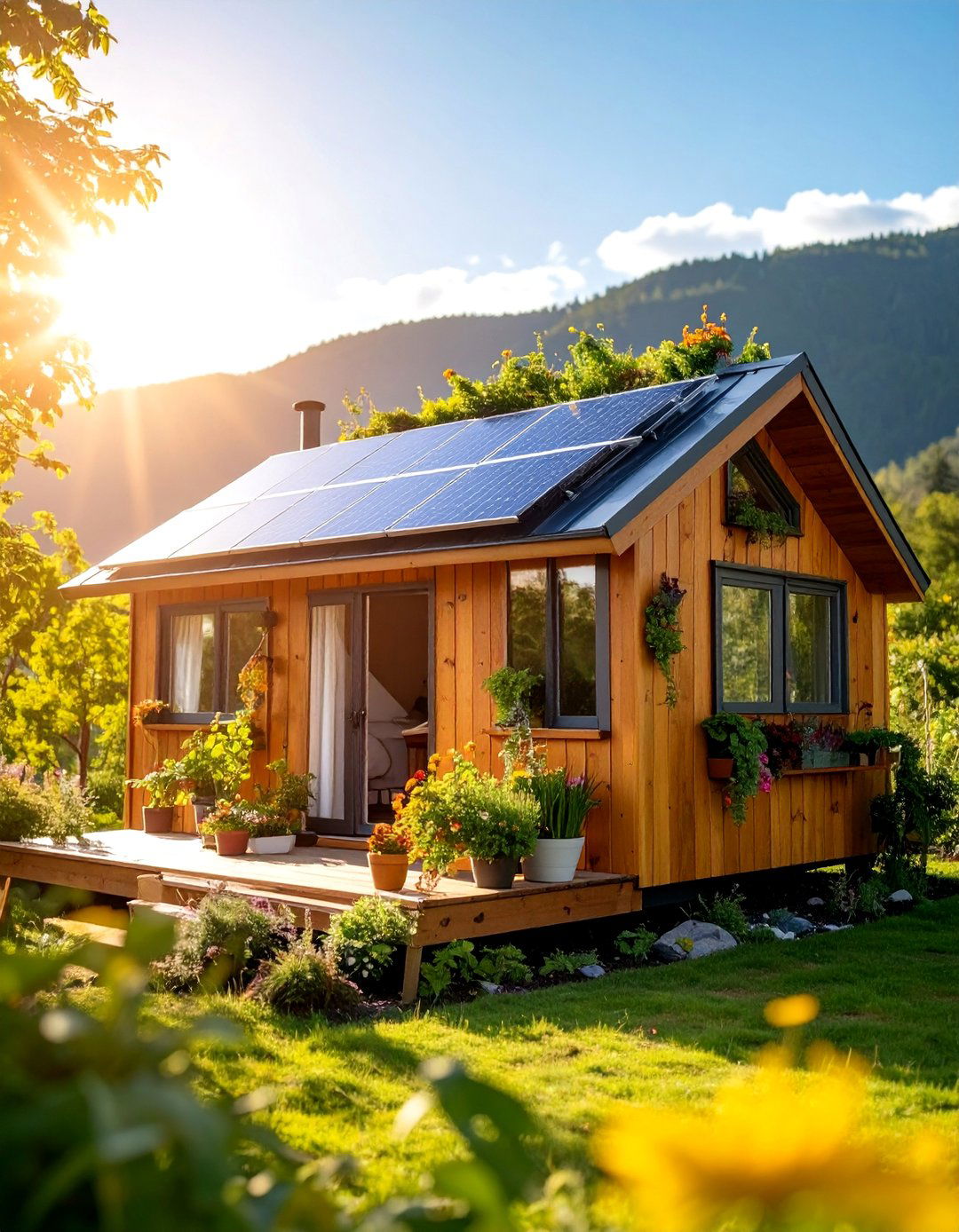







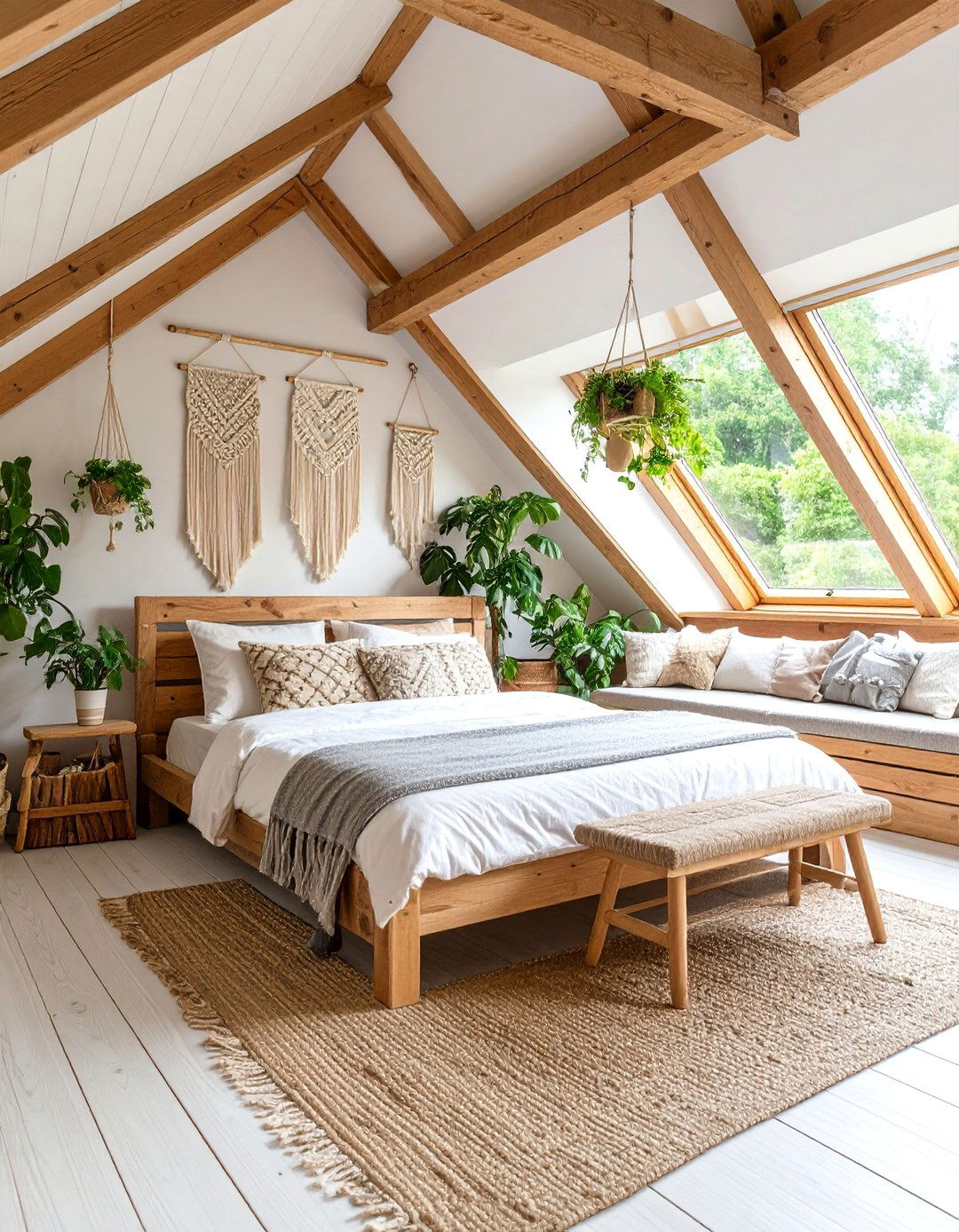

Leave a Reply